Jason Schneider
the Camera Collector
Nikkor Fest: Classic Nikon Lenses with “Retro Rendition”
Nikon has made class glass since the ‘30s… and they still do!
By Jason Schneider
Nikon was founded way back in 1917 as Nippon Kogaku K.K. (Japan Optical Industries Corporation) with the sole purpose of creating and supplying optical instruments for the Imperial Japanese military. Before and during World War II Nippon Kogaku was the chief supplier of optical instruments and lenses to the Japanese Navy. One of the first lenses to bear the Nikkor name was the 70cm f/5 Aero-Nikkor, an aerial lens that was completed in 1932 and ordered by the Air Force of the Imperial Japanese Army in 1933. Ironically, the first Nikkor lens for a 35mm camera was the bayonet mount 50mm f/3.5 Nikkor, a 4-elenent, 3-group Tessar design that was the standard lens furnished with the rangefinder Hansa Canon, the very first Canon camera, which officially went on sale in February 1936.
Japanese lenses with a German accent
After the war, Nippon Kogaku’s management knew that the company would have to switch to civilian production to survive and prosper, and began developing the first Nikon camera, an interchangeable lens rangefinder 35. The design of the new Nikon I, which was completed by 1946 and went into production in 1948, was clearly inspired by the Zeiss Contax but Nikon’s engineers wisely incorporated a simpler, more reliable Leica-type horizontal cloth focal plane shutter in place of the pre-war Contax’s complex and cantankerous vertical metal roller blind shutter. However, many of the early S-bayonet-mount Nikkors for Nikon rangefinder cameras, up to and including the magnificent Nikon SP of 1957-1960, were closely based on classic Zeiss optical designs. Prime example: the renowned 50mm f/1.4 Nikkor-S.C (which was available in Nikon-S, Contax bayonet, and Leica screw mount) was nothing more than a mildly tweaked, 1/10-stop-faster, version of the iconic 50mm f/1.5 Zeiss Sonnar, which was designed by the great Ludwig Bertele back in 1932! Indeed, as far back as the 1920’s Nippon Kogaku contracted with well-trained German lens designers to help bring their lens designing capabilities up to speed, much as the Japanese beer brewers hired German brew-masters to teach them how to make better beer!
While Nikon has long since mastered the art and science of lens design and is now one of the world’s leading optical innovators, many of the Nikon optical classics covered below, including recent examples in Nikon F-mount, retain a touch of the German esthetics-based lens design philosophy. That’s one of the reasons they can capture beautiful “retro look” images with gorgeous natural transitions despite, and sometimes because of, their optical defects! All these analog-era classics can be easily mounted on your mirrorless digital marvel or DSLR with one or more of the myriad lens adapters currently on the market.
10 Nikon Lenses With “Retro Rendition”
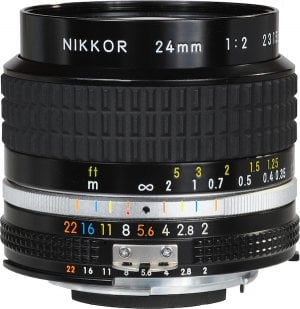
Nikkor 24mm f/2 in Nikon AI-S mount: An exceptional fast wide angle, it's a street shooter's dream.
Nikkor 24mm f/2 in Nikon F AI mount:
Introduction: August 1977
11-elements in 10 groups
CRC (Close Range Correction) Nikon’s term for floating element design
Minimum focusing distance: 0.3m
Manual focus only, by focusing ring.
Auto Diaphragm, manual aperture settings
7-bladed diaphragm
63.5mm diameter, 51.5mm length, 300g
Manufacturer’s description excerpt:
High speed, light weight, compact. Uniform field flatness and uniform edge-to-edge brightness due to improved optical system, “floating element system” yields exceptional image quality down to 0.3 meters.
Reviewers’ comments:
Great for available light street shooting because of its f/2 maximum aperture and 84-degree angle of view, but soft in the corners at f/2, slightly soft off axis at f/2.8 and quite prone to flare in harsh light. A good choice for “dreamy looking” images with good central definition at f/2 and f/2.8. Very sharp and contrasty at moderate apertures.
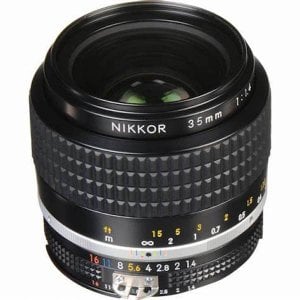
Nikon 35mm f/1.4 Nikkor AI-S introduced in 1981, the last of the breed, was in production for nearly 30 years until 2010.
Nikon NIKKOR-N and N.C Auto 35mm f/1.4:
Introduction: 1970
9 elements in 7 groups
Close Range Correction (CRC) floating element design
Minimum focusing distance: 0.3m
Auto diaphragm, manual focusing and aperture rings.
7-bladed diaphragm
66.5mm in diameter, 62.5mm in length, 415g (24.6 ounces)
Manufacturer’s description excerpt:
The fastest wide-angle Nikkor in Nikon F mount, it employs a floating element design in which the rear group of elements shifts its relative position to the other elements as the lens is focused, helping to maintain high image quality at close focusing distances. Starting with the Nikkor-N.C of 1973, multi-layer coating is used in all lenses to minimize flare and ghosting. Its wide f/1.4 aperture facilitates shooting in low light when flash is not an option. Prized by pros and very successful in the marketplace, the 9-element, 7-group 35mm f/1,4 Nikkor was produced in 4 distinct iterations, including the AI version of 1977, and the AI-S version of 1981. After an amazing run of 40 years, it was finally superseded in 2010 by the current Nikon AF-S NIKKOR 35mm f/1.4G, an autofocus lens based on a new state-of-the-art 10-element, 7-group optical design.
Reviewers’ comments:
Capable of excellent definition over the entire focusing range, the 34mm f/1.4 Nikkor delivers smooth rendition and pleasing natural bokeh at its widest apertures—not quite a full “retro look” but leaning in that direction. Barrel distortion is noticeable at close focusing distances, and internal flare, which reduces contrast at f/1.4 and f/2, can yield some attractive effects in portraits and landscapes, and if you prefer the crisp look these “defects” can be eliminated by stopping down to f/2.8. Both the AI and AI-S versions of this lens stop down to f/16; earlier examples stop down to f/22, and the earliest examples have 9-bladed diaphragms. This versatile high-speed lens has real “personality”, and for about $300-400 used, you can acquire one for less than half the price of the current Nikon AF-S NIKKOR 35mm f/1.4G.
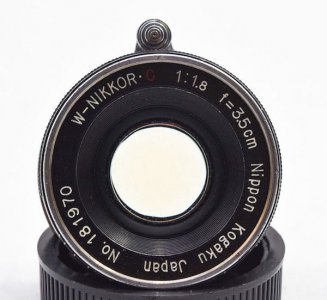
35mm f/18 W-Nikkor.C introduced in1956 was the fastest and one of the best wide-angles of its day. This is the Leica screw mount version.
Nikkor 35mm f/1.8, in Nikon S mount, Contax bayonet and LTM mount:
Introduction: 1956
7 elements in 5 groups
Minimum focusing distance: 0.9m
Manual diaphragm, manual focus
9-bladed diaphragm
Weight: 160g
Note: A limited edition of 2,500 units of this lens, known as the “pancake” lens due to its flat form factor, was produced in 2005. It has identical imaging characteristics. The F-mount Nikon AF-S Nikkor 35mm f/1.8G ED of 2014 is based on an advanced 11-element, 8-group design with 1 aspheric and 1 ED element and provides excellent imaging performance, but not “retro look” rendition.
Manufacturer’s description excerpt:
Ultra-fast wide-angle with unusually large front and rear elements to minimize vignetting, rare earth lanthanum glass is employed to enable an unusually flat field and excellent correction for aberrations at this wide maximum aperture. Click stops to f/22, minimum focus of 3 feet.
Reviewers’ comments:
Very fast for a wide-angle lens of this era, brilliant adaptation of Gauss formula enabling enhanced overall performance and outstanding resolution compared to leading competitors of its era. Gorgeous rendition with very sharp core combined with a “magic glow” in images shot wide open and at f/2.8. Extremely sharp at f/5.6 on down.
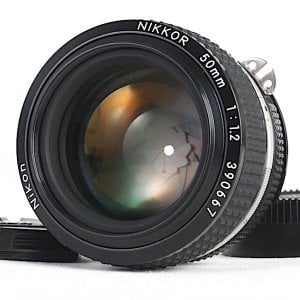
50mm f/1.2 Nikkor AI-S introduced in 1981 was the last of these classic super-speednormal lenses. Today it's a coveted and pricey collectible.
Nikon Nikkor 50mm f/1.2 in Nikon F-mount:
Introduction: AI (1977) and AI-S (1981), same optical formula
7 elements in 6 groups
Minimum focusing distance: 0.5m
9-bladed diaphragm
68.5mm diameter, 47.5mm length, 360g
Note: The current Nikon NIKKOR Z 50mm f/1.2S for Nikon Z-mount mirrorless cameras is based on a modern 17-element 15-group design and has markedly different imaging characteristics.
Manufacturer’s description excerpt:
The fastest lens in the Nikon F-mount line was available in manual focus AI and AI-S mount, was optimized for wide open performance, and is a superb choice for low light work.
Reviewers’ comments:
Super sharp, and distortion free with exceptional imaging performance at f/1.2 and peak image quality at f/2. Soft dreamy look with very shallow depth of field, relatively low contrast when shot wide open is very appealing, especially for portraiture. Stopping down to f/2 increases contrast, moderating these effects, but still captures that “retro look” and the lens captures crisp contrasty images comparable to the 50mm f/1.4 Nikkor at moderate and small apertures.
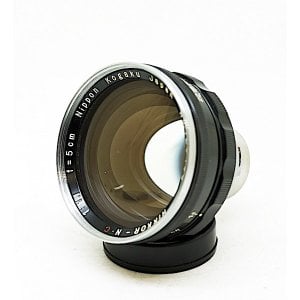
Nikon 50mm f-1.1 Nikkor-N.C rangefinder lens delivers gorgeous rendition and impressive sharpness wide open, but it's rare and pricey.
Nikon (Nippon Kogaku) 50mm f/1.1 Nikkor-N.C:
Introduction: 1956 in Nikon S-Mount, c.1959 in LTM Leica screw mount
9 elements in 6 groups
Minimum focusing distance: 0.9 m.
12-bladed diaphragm
Weight: 425g
Manufacturer’s description excerpt:
Super speed lens delivers amazingly low distortion and remarkable sharpness at full f/1.1 aperture. Lens made possible by innovative design using thin split elements and air spacing, click stops to f/22, minimum focus of 3 feet.
Reviewers’ comments:
A radical lens for its era using very thin split elements and rare earth glass, yielding remarkable wide-open imaging performance; versions available for internal Nikon bayonet mount (1,500 units), external Nikon bayonet mount (1,800 units) and LTM Leica screw mount (200 units). Can be professionally modified for Leica M mount. Gorgeous “retro look” rendition at f/1.1 reminiscent of the 50mm f/1.4 Nikkor-S.C—sharp but with a “vintage glow” wide open, moderated at f/2 and with some softness in the corners of the field that are eliminated by about f/2.8. Extremely shallow depth of field contributes to its ethereal effect at its widest aperture, making it a great lens for portraiture. Note: this relatively rare gem currently fetches $2k to $5k used in Nikon mount and $7k on up in Leica screw mount or modified M-mount.
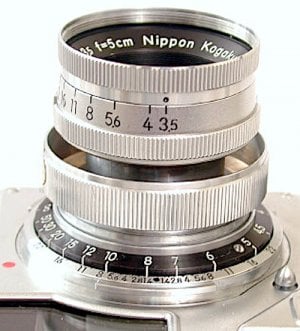
50mm f-3.5 Micro-NIKKOR-C collapsible lens was the sharpest Nikkor of its day and gave a choice of 2 magnification/focusing ranges.
50mm f/3.5 Micro-NIKKOR-C collapsible:
Introduction: 1956
5 elements in 4 groups
Minimum focusing distance: 0.9m extended, 0.45m collapsed.
Rangefinder coupled in extended position, manual focus.
7-bladed diaphragm, click stops to f/22
Weight: 145g (4.8 ounces)
Manufacturer’s description excerpt:
Available in chrome finish only. Total production: 1,188 (901 in Nikon S bayonet mount, 287 in Leica screw mount (LTM). When mounted on a copy stand the lens can be used from 1/20 reduction to life-size (1:1); when collapsed it ranges from 1/6 to 1/20 life-size. This unique lens provides exceptional resolving power and claimed apochromatic color correction (though never listed as an apochromat by Nikon) and is a great choice for copying, close-up work, and general photography when a high-speed lens is not essential. The legendary 55mm f/3.5 Micro-Nikkor in F-mount used the same optical formula and was one of Nikon’s finest and most popular macro lenses.
Reviewers’ comments:
At the time it was made this lens delivered the highest resolution of any Nikon lens in production. Based on a modified Petzval symmetrical formula it was designed to capture extremely fine detail at close focusing distances, achieving optimum performance at a 1:12 magnification ratio. It is not used for general photography in collapsed mode, but in extended mode it’s extremely sharp across the entire image field at all apertures, has beautiful natural bokeh that’s especially attractive between f/3.5 and f/5.6, and gorgeous rendition with a distinctive retro touch. The bad news: this rare and wonderful lens goes for about $2k in Nikon S bayonet mount and up to twice that much in Leica screw mount—if you can even find one for sale. The good news: You can snag a 55mm f/3.5 Micro-Nikkor in Nikon F-mount for $100-$200 and get virtually the same imaging characteristics in a less exclusive but more convenient package.
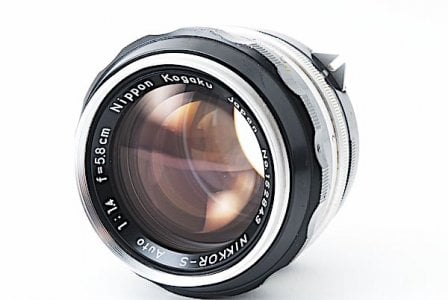
The first f/1.4 "normal" lens for the Nikon F, the Nikon 58mm f/1.4 Nikkor-S isn't as sharp as the later 50mm f/1.4, but it has better bokeh.
Nikon 58mm f/1.4 Nikkor-S:
Introduction: October 1959. Discontinued: January 1962.
7 elements in 6 groups
Minimum focusing distance: 0.6m.
Auto diaphragm, manual focus only
6-bladed diaphragm with full stop clicks to f/16
67mm diameter, 47.5mm length, 350g
Manufacturer’s description excerpt:
An F-mount version of the 50mm f/1.4 Nikkor-S.C would have had too short a flange focal distance to clear the Nikon F’s reflex mirror, so Nikon increased the focal length to 58mm and offered this lens until it was able to design an improved 50mm f/1.4 to work on its SLRs.
Reviewers’ comments:
The 58mm f/1.4 Nikkor provides a satisfying life-size (1:1) viewing image and a maximum reproduction ratio of 1:8.4 at 2 feet, but it’s not quite as sharp or contrasty wide open as its successor, the 50mm f/1.4 Nikkor. On the plus side, it does deliver something approaching the softish dreamy “retro look” at f/1.4 and f/2, and overall has much nicer bokeh and smoother transitions than its 50mm successor. At least part of its pleasing rendition is attributable to under-corrected aberrations, but these “defects,” and very shallow depth of field, can be put to good use when shooting portraits, still life compositions, and other “artistic” subjects. Nikon thought enough of the concept to offer a modern equivalent, theAF-S NIKKOR 58mm f/1.4G, that employs a cutting-edge optical formula, but retails at over $1,400, The good news you can snag a clean, functional vintage example for around $300.
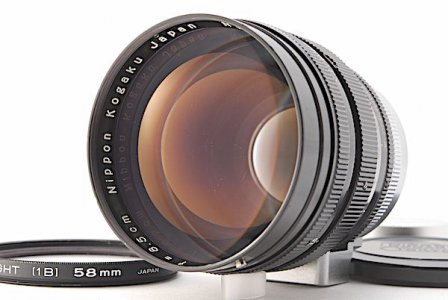
A remarkable achievement for its day, the 85mm f/1.5 Nikkor-S provides impressive image quality and a gorgeous "vintage glow" at f/1.5-f/2.0.
85mm f/1.5 Nikkor-S.C:
Introduction: 1953
7 elements in 3 groups
Minimum Focusing Distance: 1 meter.
Manual focus, rangefinder coupled, Nikon S bayonet mount.
16-bladed diaphragm
Weight: 550g
Manufacturer’s description excerpt:
High speed, high resolution long-focus lens optimized for low light shooting, provides 1.7x magnification and 28.5-degree coverage, click-stops to f/32, focus to 3.5 feet.
Reviewers’ comments:
Based on recomputed optical formulas and advances in glass technology that made the breakthrough 50mm f.1.4 Nikkor-S.C possible, it has similar rendition with excellent detail and sharpness in the center of the field at f/1.5 and f/2 along with a distinctive “vintage glow,” and smooth natural rendition with outstanding detail at smaller apertures. A superb vintage portrait telephoto available in both Nikon-S and Leica screw mount (LTM), but examples of the latter are super-rare and priced accordingly ($4K-$5k).
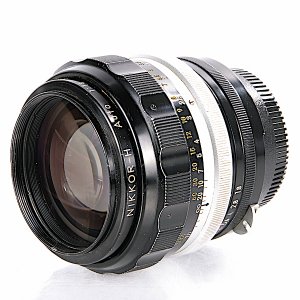
Nikon Nikkor-H Auto 85mm f/1.8 and later H.C version deliver high speed, great image quality, and creamy bokeh at their widest apertures,
Nikon Nikkor-H and Nikkor H.C Auto 85mm f/1.8:
Introduction: 1964 Nikkor-H single coated; 1972 Nikkor-H.C multicoated
6 elements in 4 groups, symmetrical
Minimum focusing distance: 1 m (1964-1975) 0.85m (1975-1977)
Manual focus, auto diaphragm with manual aperture ring
6-bladed diaphragm with straight blades, apertures to f/22.
72mm in diameter, 62mm in length, 430g
Manufacturer’s description excerpt:
This high speed medium tele lens in Nikon F mount offers exceptional definition even at maximum aperture, making it suitable for low light applications, especially sports and portraiture. Its natural perspective is useful in portraiture, theatrical photography, and photojournalism, it has outstanding resolution and contrast at maximum aperture, and its symmetrical design ensures good performance at close range.
Reviewers’ comments:
The first 85mm lens for the Nikon F, it was in production for nearly 15 years with only minor changes, and became the mainstay of countless pros. Later multicoated versions are less susceptible to flare, and all are commendably sharp in the center the field at the widest apertures, with only some slight softness in the corners, achieving peak performance at f/8. Nikon’s 85mm f/1.8 is a superb portrait lens coveted for its creamy bokeh, smooth natural rendition, and beautiful “retro Look” when shot wide open or at f/2.8. When stopped down to f/5.6 and smaller apertures it’s exquisitely sharp and contrasty, but can capture distracting “beehive pattern” out of focus highlights thank to its straight-bladed hexagonal diaphragm.
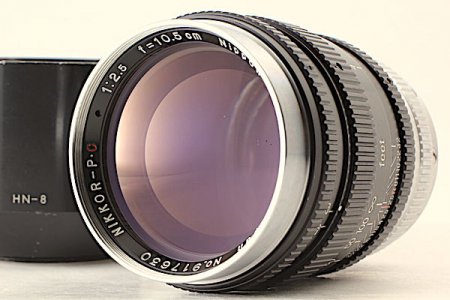
The original Nikon NIKKOR-P.C 105mm f/2.5: A sharp, fast,"cult classic" acclaimed for its superb rendition. This one's in Leica screw mount..
Nikon NIKKOR-P.C 105mm f/2.5:
Introduction: 1954 in Nikon S-mount, c. 1956 in Leica screw mount
5 elements in 3 groups
Minimum focusing distance: 1.2m (4 feet),
\Manual focus, rangefinder coupled.
10-bladed diaphragm with click stops to f/32
Weight: 510g
Manufacturer’s description excerpt:
Combining high speed and high definition, this long-focus portrait telephoto prime delivers a 2.1x magnification compared to a 50mm normal lens along with outstanding resolution even wide open at f/2.5. It’s a superb portrait lens but also great general-purpose lens, delivering an attractive perspective, excellent detail rendition, and impressive light-gathering power, in a compact, well-balanced package. Indeed, these are some of the reasons that it was extremely popular in its day, has attained the status if a cult classic, and eventually made the transition to F-mount using virtually the same optical formula.
Reviewers’ comments:
This classic vintage lens delivers beautiful “retro look” images at its widest apertures, along with outstanding definition and detail in the canter of the field and slight softness in the extreme corners. Stop it down to f/8 and smaller apertures and it’s extremely sharp across the filed with just enough vintage character to set it apart from modern lenses. This lens earned its stripes as a cult classic, and fortunately almost all its vintage character was retained in its transition to Nikon F-mount in the Nikon NIKKOR-P Auto 105mm f/2.5 in 1959.
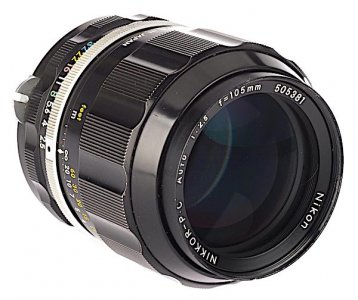
105mm f/2.5 NIKKOR-P.C of 1971 was the first to employ the closer focusing 5-element, 4-group design, but its rendition was little changed.
Nikon NIKKOR-P Auto 105mm f/2.5:
Introduction: April 1959
5 elements in 3 groups
Minimum focusing distance: 1.2m (4 feet)
Manual focus, auto diaphragm, manual aperture ring
6-bladed diaphragm, straight blades, click stops to f/22
66mm in diameter, 64.6mm in length, 370g
Manufacturer’s description excerpt:
One of the most popular moderate telephoto lenses for F-mount Nikon cameras, it was introduced in 1959 along with the landmark Nikon F. Acclaimed for its high speed, high resolution, natural portrait perspective and “luminous” rendition, the first version used the same optical formula as the original rangefinder version of 1954 and focused down to 4 feet. Subsequent iterations, starting with the Nikon NIKKOR-P.C Auto 105mm f/2.5 of 1971 and ending with the Nikon AI-S NIKKOR 105mm f/2.5 of 1981, used a modified 5-element 4-group formula that enabled focusing down to 3.3 feet, enhancing the 105’s closeup capabilities while maintaining its much-admired imaging characteristics. Perhaps the most popular long focus Nikkor of all time, the F-mount 105mm f/2.5 NIKKOR is a great choice fort portraiture, indoor stage photography, and night photography.
Reviewers’ comments:
In production for a remarkable 46 years (1959-2005), the iconic F-mount Nikkor 105mm f/2.5 is a mechanical and optical masterpiece that can pass objective lens tests with flying colors and can also capture images of surpassing beauty thanks to its smooth transitions, beautiful bokeh, and charming natural rendition (except for distracting hexagonal patterns in out-of-focus highlights). Best news: you can currently snag a nice used example of this timeless classic online for $100-$300 depending on its cosmetic condition and the specific version.
Nikon has made class glass since the ‘30s… and they still do!
By Jason Schneider
Nikon was founded way back in 1917 as Nippon Kogaku K.K. (Japan Optical Industries Corporation) with the sole purpose of creating and supplying optical instruments for the Imperial Japanese military. Before and during World War II Nippon Kogaku was the chief supplier of optical instruments and lenses to the Japanese Navy. One of the first lenses to bear the Nikkor name was the 70cm f/5 Aero-Nikkor, an aerial lens that was completed in 1932 and ordered by the Air Force of the Imperial Japanese Army in 1933. Ironically, the first Nikkor lens for a 35mm camera was the bayonet mount 50mm f/3.5 Nikkor, a 4-elenent, 3-group Tessar design that was the standard lens furnished with the rangefinder Hansa Canon, the very first Canon camera, which officially went on sale in February 1936.
Japanese lenses with a German accent
After the war, Nippon Kogaku’s management knew that the company would have to switch to civilian production to survive and prosper, and began developing the first Nikon camera, an interchangeable lens rangefinder 35. The design of the new Nikon I, which was completed by 1946 and went into production in 1948, was clearly inspired by the Zeiss Contax but Nikon’s engineers wisely incorporated a simpler, more reliable Leica-type horizontal cloth focal plane shutter in place of the pre-war Contax’s complex and cantankerous vertical metal roller blind shutter. However, many of the early S-bayonet-mount Nikkors for Nikon rangefinder cameras, up to and including the magnificent Nikon SP of 1957-1960, were closely based on classic Zeiss optical designs. Prime example: the renowned 50mm f/1.4 Nikkor-S.C (which was available in Nikon-S, Contax bayonet, and Leica screw mount) was nothing more than a mildly tweaked, 1/10-stop-faster, version of the iconic 50mm f/1.5 Zeiss Sonnar, which was designed by the great Ludwig Bertele back in 1932! Indeed, as far back as the 1920’s Nippon Kogaku contracted with well-trained German lens designers to help bring their lens designing capabilities up to speed, much as the Japanese beer brewers hired German brew-masters to teach them how to make better beer!
While Nikon has long since mastered the art and science of lens design and is now one of the world’s leading optical innovators, many of the Nikon optical classics covered below, including recent examples in Nikon F-mount, retain a touch of the German esthetics-based lens design philosophy. That’s one of the reasons they can capture beautiful “retro look” images with gorgeous natural transitions despite, and sometimes because of, their optical defects! All these analog-era classics can be easily mounted on your mirrorless digital marvel or DSLR with one or more of the myriad lens adapters currently on the market.
10 Nikon Lenses With “Retro Rendition”

Nikkor 24mm f/2 in Nikon AI-S mount: An exceptional fast wide angle, it's a street shooter's dream.
Nikkor 24mm f/2 in Nikon F AI mount:
Introduction: August 1977
11-elements in 10 groups
CRC (Close Range Correction) Nikon’s term for floating element design
Minimum focusing distance: 0.3m
Manual focus only, by focusing ring.
Auto Diaphragm, manual aperture settings
7-bladed diaphragm
63.5mm diameter, 51.5mm length, 300g
Manufacturer’s description excerpt:
High speed, light weight, compact. Uniform field flatness and uniform edge-to-edge brightness due to improved optical system, “floating element system” yields exceptional image quality down to 0.3 meters.
Reviewers’ comments:
Great for available light street shooting because of its f/2 maximum aperture and 84-degree angle of view, but soft in the corners at f/2, slightly soft off axis at f/2.8 and quite prone to flare in harsh light. A good choice for “dreamy looking” images with good central definition at f/2 and f/2.8. Very sharp and contrasty at moderate apertures.

Nikon 35mm f/1.4 Nikkor AI-S introduced in 1981, the last of the breed, was in production for nearly 30 years until 2010.
Nikon NIKKOR-N and N.C Auto 35mm f/1.4:
Introduction: 1970
9 elements in 7 groups
Close Range Correction (CRC) floating element design
Minimum focusing distance: 0.3m
Auto diaphragm, manual focusing and aperture rings.
7-bladed diaphragm
66.5mm in diameter, 62.5mm in length, 415g (24.6 ounces)
Manufacturer’s description excerpt:
The fastest wide-angle Nikkor in Nikon F mount, it employs a floating element design in which the rear group of elements shifts its relative position to the other elements as the lens is focused, helping to maintain high image quality at close focusing distances. Starting with the Nikkor-N.C of 1973, multi-layer coating is used in all lenses to minimize flare and ghosting. Its wide f/1.4 aperture facilitates shooting in low light when flash is not an option. Prized by pros and very successful in the marketplace, the 9-element, 7-group 35mm f/1,4 Nikkor was produced in 4 distinct iterations, including the AI version of 1977, and the AI-S version of 1981. After an amazing run of 40 years, it was finally superseded in 2010 by the current Nikon AF-S NIKKOR 35mm f/1.4G, an autofocus lens based on a new state-of-the-art 10-element, 7-group optical design.
Reviewers’ comments:
Capable of excellent definition over the entire focusing range, the 34mm f/1.4 Nikkor delivers smooth rendition and pleasing natural bokeh at its widest apertures—not quite a full “retro look” but leaning in that direction. Barrel distortion is noticeable at close focusing distances, and internal flare, which reduces contrast at f/1.4 and f/2, can yield some attractive effects in portraits and landscapes, and if you prefer the crisp look these “defects” can be eliminated by stopping down to f/2.8. Both the AI and AI-S versions of this lens stop down to f/16; earlier examples stop down to f/22, and the earliest examples have 9-bladed diaphragms. This versatile high-speed lens has real “personality”, and for about $300-400 used, you can acquire one for less than half the price of the current Nikon AF-S NIKKOR 35mm f/1.4G.

35mm f/18 W-Nikkor.C introduced in1956 was the fastest and one of the best wide-angles of its day. This is the Leica screw mount version.
Nikkor 35mm f/1.8, in Nikon S mount, Contax bayonet and LTM mount:
Introduction: 1956
7 elements in 5 groups
Minimum focusing distance: 0.9m
Manual diaphragm, manual focus
9-bladed diaphragm
Weight: 160g
Note: A limited edition of 2,500 units of this lens, known as the “pancake” lens due to its flat form factor, was produced in 2005. It has identical imaging characteristics. The F-mount Nikon AF-S Nikkor 35mm f/1.8G ED of 2014 is based on an advanced 11-element, 8-group design with 1 aspheric and 1 ED element and provides excellent imaging performance, but not “retro look” rendition.
Manufacturer’s description excerpt:
Ultra-fast wide-angle with unusually large front and rear elements to minimize vignetting, rare earth lanthanum glass is employed to enable an unusually flat field and excellent correction for aberrations at this wide maximum aperture. Click stops to f/22, minimum focus of 3 feet.
Reviewers’ comments:
Very fast for a wide-angle lens of this era, brilliant adaptation of Gauss formula enabling enhanced overall performance and outstanding resolution compared to leading competitors of its era. Gorgeous rendition with very sharp core combined with a “magic glow” in images shot wide open and at f/2.8. Extremely sharp at f/5.6 on down.

50mm f/1.2 Nikkor AI-S introduced in 1981 was the last of these classic super-speednormal lenses. Today it's a coveted and pricey collectible.
Nikon Nikkor 50mm f/1.2 in Nikon F-mount:
Introduction: AI (1977) and AI-S (1981), same optical formula
7 elements in 6 groups
Minimum focusing distance: 0.5m
9-bladed diaphragm
68.5mm diameter, 47.5mm length, 360g
Note: The current Nikon NIKKOR Z 50mm f/1.2S for Nikon Z-mount mirrorless cameras is based on a modern 17-element 15-group design and has markedly different imaging characteristics.
Manufacturer’s description excerpt:
The fastest lens in the Nikon F-mount line was available in manual focus AI and AI-S mount, was optimized for wide open performance, and is a superb choice for low light work.
Reviewers’ comments:
Super sharp, and distortion free with exceptional imaging performance at f/1.2 and peak image quality at f/2. Soft dreamy look with very shallow depth of field, relatively low contrast when shot wide open is very appealing, especially for portraiture. Stopping down to f/2 increases contrast, moderating these effects, but still captures that “retro look” and the lens captures crisp contrasty images comparable to the 50mm f/1.4 Nikkor at moderate and small apertures.

Nikon 50mm f-1.1 Nikkor-N.C rangefinder lens delivers gorgeous rendition and impressive sharpness wide open, but it's rare and pricey.
Nikon (Nippon Kogaku) 50mm f/1.1 Nikkor-N.C:
Introduction: 1956 in Nikon S-Mount, c.1959 in LTM Leica screw mount
9 elements in 6 groups
Minimum focusing distance: 0.9 m.
12-bladed diaphragm
Weight: 425g
Manufacturer’s description excerpt:
Super speed lens delivers amazingly low distortion and remarkable sharpness at full f/1.1 aperture. Lens made possible by innovative design using thin split elements and air spacing, click stops to f/22, minimum focus of 3 feet.
Reviewers’ comments:
A radical lens for its era using very thin split elements and rare earth glass, yielding remarkable wide-open imaging performance; versions available for internal Nikon bayonet mount (1,500 units), external Nikon bayonet mount (1,800 units) and LTM Leica screw mount (200 units). Can be professionally modified for Leica M mount. Gorgeous “retro look” rendition at f/1.1 reminiscent of the 50mm f/1.4 Nikkor-S.C—sharp but with a “vintage glow” wide open, moderated at f/2 and with some softness in the corners of the field that are eliminated by about f/2.8. Extremely shallow depth of field contributes to its ethereal effect at its widest aperture, making it a great lens for portraiture. Note: this relatively rare gem currently fetches $2k to $5k used in Nikon mount and $7k on up in Leica screw mount or modified M-mount.

50mm f-3.5 Micro-NIKKOR-C collapsible lens was the sharpest Nikkor of its day and gave a choice of 2 magnification/focusing ranges.
50mm f/3.5 Micro-NIKKOR-C collapsible:
Introduction: 1956
5 elements in 4 groups
Minimum focusing distance: 0.9m extended, 0.45m collapsed.
Rangefinder coupled in extended position, manual focus.
7-bladed diaphragm, click stops to f/22
Weight: 145g (4.8 ounces)
Manufacturer’s description excerpt:
Available in chrome finish only. Total production: 1,188 (901 in Nikon S bayonet mount, 287 in Leica screw mount (LTM). When mounted on a copy stand the lens can be used from 1/20 reduction to life-size (1:1); when collapsed it ranges from 1/6 to 1/20 life-size. This unique lens provides exceptional resolving power and claimed apochromatic color correction (though never listed as an apochromat by Nikon) and is a great choice for copying, close-up work, and general photography when a high-speed lens is not essential. The legendary 55mm f/3.5 Micro-Nikkor in F-mount used the same optical formula and was one of Nikon’s finest and most popular macro lenses.
Reviewers’ comments:
At the time it was made this lens delivered the highest resolution of any Nikon lens in production. Based on a modified Petzval symmetrical formula it was designed to capture extremely fine detail at close focusing distances, achieving optimum performance at a 1:12 magnification ratio. It is not used for general photography in collapsed mode, but in extended mode it’s extremely sharp across the entire image field at all apertures, has beautiful natural bokeh that’s especially attractive between f/3.5 and f/5.6, and gorgeous rendition with a distinctive retro touch. The bad news: this rare and wonderful lens goes for about $2k in Nikon S bayonet mount and up to twice that much in Leica screw mount—if you can even find one for sale. The good news: You can snag a 55mm f/3.5 Micro-Nikkor in Nikon F-mount for $100-$200 and get virtually the same imaging characteristics in a less exclusive but more convenient package.

The first f/1.4 "normal" lens for the Nikon F, the Nikon 58mm f/1.4 Nikkor-S isn't as sharp as the later 50mm f/1.4, but it has better bokeh.
Nikon 58mm f/1.4 Nikkor-S:
Introduction: October 1959. Discontinued: January 1962.
7 elements in 6 groups
Minimum focusing distance: 0.6m.
Auto diaphragm, manual focus only
6-bladed diaphragm with full stop clicks to f/16
67mm diameter, 47.5mm length, 350g
Manufacturer’s description excerpt:
An F-mount version of the 50mm f/1.4 Nikkor-S.C would have had too short a flange focal distance to clear the Nikon F’s reflex mirror, so Nikon increased the focal length to 58mm and offered this lens until it was able to design an improved 50mm f/1.4 to work on its SLRs.
Reviewers’ comments:
The 58mm f/1.4 Nikkor provides a satisfying life-size (1:1) viewing image and a maximum reproduction ratio of 1:8.4 at 2 feet, but it’s not quite as sharp or contrasty wide open as its successor, the 50mm f/1.4 Nikkor. On the plus side, it does deliver something approaching the softish dreamy “retro look” at f/1.4 and f/2, and overall has much nicer bokeh and smoother transitions than its 50mm successor. At least part of its pleasing rendition is attributable to under-corrected aberrations, but these “defects,” and very shallow depth of field, can be put to good use when shooting portraits, still life compositions, and other “artistic” subjects. Nikon thought enough of the concept to offer a modern equivalent, theAF-S NIKKOR 58mm f/1.4G, that employs a cutting-edge optical formula, but retails at over $1,400, The good news you can snag a clean, functional vintage example for around $300.

A remarkable achievement for its day, the 85mm f/1.5 Nikkor-S provides impressive image quality and a gorgeous "vintage glow" at f/1.5-f/2.0.
85mm f/1.5 Nikkor-S.C:
Introduction: 1953
7 elements in 3 groups
Minimum Focusing Distance: 1 meter.
Manual focus, rangefinder coupled, Nikon S bayonet mount.
16-bladed diaphragm
Weight: 550g
Manufacturer’s description excerpt:
High speed, high resolution long-focus lens optimized for low light shooting, provides 1.7x magnification and 28.5-degree coverage, click-stops to f/32, focus to 3.5 feet.
Reviewers’ comments:
Based on recomputed optical formulas and advances in glass technology that made the breakthrough 50mm f.1.4 Nikkor-S.C possible, it has similar rendition with excellent detail and sharpness in the center of the field at f/1.5 and f/2 along with a distinctive “vintage glow,” and smooth natural rendition with outstanding detail at smaller apertures. A superb vintage portrait telephoto available in both Nikon-S and Leica screw mount (LTM), but examples of the latter are super-rare and priced accordingly ($4K-$5k).

Nikon Nikkor-H Auto 85mm f/1.8 and later H.C version deliver high speed, great image quality, and creamy bokeh at their widest apertures,
Nikon Nikkor-H and Nikkor H.C Auto 85mm f/1.8:
Introduction: 1964 Nikkor-H single coated; 1972 Nikkor-H.C multicoated
6 elements in 4 groups, symmetrical
Minimum focusing distance: 1 m (1964-1975) 0.85m (1975-1977)
Manual focus, auto diaphragm with manual aperture ring
6-bladed diaphragm with straight blades, apertures to f/22.
72mm in diameter, 62mm in length, 430g
Manufacturer’s description excerpt:
This high speed medium tele lens in Nikon F mount offers exceptional definition even at maximum aperture, making it suitable for low light applications, especially sports and portraiture. Its natural perspective is useful in portraiture, theatrical photography, and photojournalism, it has outstanding resolution and contrast at maximum aperture, and its symmetrical design ensures good performance at close range.
Reviewers’ comments:
The first 85mm lens for the Nikon F, it was in production for nearly 15 years with only minor changes, and became the mainstay of countless pros. Later multicoated versions are less susceptible to flare, and all are commendably sharp in the center the field at the widest apertures, with only some slight softness in the corners, achieving peak performance at f/8. Nikon’s 85mm f/1.8 is a superb portrait lens coveted for its creamy bokeh, smooth natural rendition, and beautiful “retro Look” when shot wide open or at f/2.8. When stopped down to f/5.6 and smaller apertures it’s exquisitely sharp and contrasty, but can capture distracting “beehive pattern” out of focus highlights thank to its straight-bladed hexagonal diaphragm.

The original Nikon NIKKOR-P.C 105mm f/2.5: A sharp, fast,"cult classic" acclaimed for its superb rendition. This one's in Leica screw mount..
Nikon NIKKOR-P.C 105mm f/2.5:
Introduction: 1954 in Nikon S-mount, c. 1956 in Leica screw mount
5 elements in 3 groups
Minimum focusing distance: 1.2m (4 feet),
\Manual focus, rangefinder coupled.
10-bladed diaphragm with click stops to f/32
Weight: 510g
Manufacturer’s description excerpt:
Combining high speed and high definition, this long-focus portrait telephoto prime delivers a 2.1x magnification compared to a 50mm normal lens along with outstanding resolution even wide open at f/2.5. It’s a superb portrait lens but also great general-purpose lens, delivering an attractive perspective, excellent detail rendition, and impressive light-gathering power, in a compact, well-balanced package. Indeed, these are some of the reasons that it was extremely popular in its day, has attained the status if a cult classic, and eventually made the transition to F-mount using virtually the same optical formula.
Reviewers’ comments:
This classic vintage lens delivers beautiful “retro look” images at its widest apertures, along with outstanding definition and detail in the canter of the field and slight softness in the extreme corners. Stop it down to f/8 and smaller apertures and it’s extremely sharp across the filed with just enough vintage character to set it apart from modern lenses. This lens earned its stripes as a cult classic, and fortunately almost all its vintage character was retained in its transition to Nikon F-mount in the Nikon NIKKOR-P Auto 105mm f/2.5 in 1959.

105mm f/2.5 NIKKOR-P.C of 1971 was the first to employ the closer focusing 5-element, 4-group design, but its rendition was little changed.
Nikon NIKKOR-P Auto 105mm f/2.5:
Introduction: April 1959
5 elements in 3 groups
Minimum focusing distance: 1.2m (4 feet)
Manual focus, auto diaphragm, manual aperture ring
6-bladed diaphragm, straight blades, click stops to f/22
66mm in diameter, 64.6mm in length, 370g
Manufacturer’s description excerpt:
One of the most popular moderate telephoto lenses for F-mount Nikon cameras, it was introduced in 1959 along with the landmark Nikon F. Acclaimed for its high speed, high resolution, natural portrait perspective and “luminous” rendition, the first version used the same optical formula as the original rangefinder version of 1954 and focused down to 4 feet. Subsequent iterations, starting with the Nikon NIKKOR-P.C Auto 105mm f/2.5 of 1971 and ending with the Nikon AI-S NIKKOR 105mm f/2.5 of 1981, used a modified 5-element 4-group formula that enabled focusing down to 3.3 feet, enhancing the 105’s closeup capabilities while maintaining its much-admired imaging characteristics. Perhaps the most popular long focus Nikkor of all time, the F-mount 105mm f/2.5 NIKKOR is a great choice fort portraiture, indoor stage photography, and night photography.
Reviewers’ comments:
In production for a remarkable 46 years (1959-2005), the iconic F-mount Nikkor 105mm f/2.5 is a mechanical and optical masterpiece that can pass objective lens tests with flying colors and can also capture images of surpassing beauty thanks to its smooth transitions, beautiful bokeh, and charming natural rendition (except for distracting hexagonal patterns in out-of-focus highlights). Best news: you can currently snag a nice used example of this timeless classic online for $100-$300 depending on its cosmetic condition and the specific version.
Last edited:
KoNickon
Nick Merritt
Some real classics here! My local store has a 50/1.2 -- maybe just for ha-ha's I'll ask him what he wants for it. North of $500 I'm sure. I have a well-worn P-C (I think -- purple coating) version of the 35/1.4. It's been sitting in a sunny place over the winter to clear up the sepia discoloration of the glass -- almost back to normal.
wlewisiii
Just another hotel clerk
The only one of these that I own is the 105/2.5 and it is a delight in the right circumstance. I'll have to keep my eyes open for the rest.
Dogman
Mentor
The 85/1.8 was a great lens for a "short-long" focal length. I owned one at the same time as 90mm Summicron and I thought the Nikkor images were better. I also have a 105/2.5 (almost everyone has one these days). Really a very useful and outstanding lens that has replaced the 85mm focal length for me--unless I want to use the 85/1.4 Nikkor "cream machine".
I use the 24/2 AI and like it but I have a lot more experience with the 24/2.8 in every one of its incarnations over time. IMO, a 24/25mm is a near perfect wide angle focal length. All the older Nikkors I've used have great retro renderings.
Thanks for this, Jason.
I use the 24/2 AI and like it but I have a lot more experience with the 24/2.8 in every one of its incarnations over time. IMO, a 24/25mm is a near perfect wide angle focal length. All the older Nikkors I've used have great retro renderings.
Thanks for this, Jason.
I scored 7/10 on these...
wlewisiii
Just another hotel clerk
I expected 10/10 out of you Brian 
Contarama
Well-known
I expected him to be 10/10 and then add 5 more to the list. I bet he hasn't given it much thought yet.I expected 10/10 out of you Brian
Tim Murphy
Well-known
Dear Board,
I have the 58mm F1.4 S that was my grandfather's. The lens that shot every significant, and some less than significant events in the lives of his 6 grandchildren, mostly on Kodachrome 64.
I had it refurbished a couple of years ago because of weepy aperture blades. It now sits on his Nikon FTN I inherited. It gets a roll through it every year since I had the camera refurbished.
But now that I have collected 28, 35, 135, and 200mm Nikkor S lenses of the same vintage, and I have a Lab-Box coming I plan to use everything much more frequently.
Regards,
Tim Murphy
Harrisburg PA
I have the 58mm F1.4 S that was my grandfather's. The lens that shot every significant, and some less than significant events in the lives of his 6 grandchildren, mostly on Kodachrome 64.
I had it refurbished a couple of years ago because of weepy aperture blades. It now sits on his Nikon FTN I inherited. It gets a roll through it every year since I had the camera refurbished.
But now that I have collected 28, 35, 135, and 200mm Nikkor S lenses of the same vintage, and I have a Lab-Box coming I plan to use everything much more frequently.
Regards,
Tim Murphy
Harrisburg PA
Five that I treasure...I expected him to be 10/10 and then add 5 more to the list. I bet he hasn't given it much thought yet.
 Nikkor 1940s Set by fiftyonepointsix, on Flickr
Nikkor 1940s Set by fiftyonepointsix, on Flickrlukx
Well-known
I like how the Nikkor 5cm 1.5 just sneakily sits in there with its much more common siblings. Truly a rare gem. The collapsible f2 Sonnar is also really cool, doesn't get much more compact than that... But the 8.5cm f2 is absolutely one of my all time favourite lenses on film.
The 5cm F1.5 and 13.5cm F4 Nikkors are what David Douglas Duncan used for "This is War". I have a 1st Edition of it to go with the lenses.
Not many of these were made before Nikon went to the 5cm F1.4 and 13.5cm F3.5, both out in 1950. I have a 1st batch 5cm F1.4 and a MIOJ 13.5cm F3.5.
Not many of these were made before Nikon went to the 5cm F1.4 and 13.5cm F3.5, both out in 1950. I have a 1st batch 5cm F1.4 and a MIOJ 13.5cm F3.5.
Tim Read
Established
Brian, I have a good copy of the Nikkor PC 1:2 f = 85 cm Nippon Kogaku Japan lens, s/n 397784. I have read what I think is available on the net about this lens including that it was the one used by an assistant to take a shot (of him?) which caused him to visit Nikon. I have read seemingly conflicted accounts of whether he used this lens at all in Korea. Some say yes, and many say no. Would you mind adding of your own insights to that. I enjoy it greatly as a portrait lens but also for its rendition of beach shots I take here at Bondi Beach, Australia. Thanks.The 5cm F1.5 and 13.5cm F4 Nikkors are what David Douglas Duncan used for "This is War". I have a 1st Edition of it to go with the lenses.
Not many of these were made before Nikon went to the 5cm F1.4 and 13.5cm F3.5, both out in 1950. I have a 1st batch 5cm F1.4 and a MIOJ 13.5cm F3.5.
Erik van Straten
Mentor
gelatin silver print (nikkor 50mm f2 ltm) leica lll
Amsterdam Centraal Station 2023
Erik.

Amsterdam Centraal Station 2023
Erik.

Brian, I have a good copy of the Nikkor PC 1:2 f = 85 cm Nippon Kogaku Japan lens, s/n 397784. I have read what I think is available on the net about this lens including that it was the one used by an assistant to take a shot (of him?) which caused him to visit Nikon. I have read seemingly conflicted accounts of whether he used this lens at all in Korea. Some say yes, and many say no. Would you mind adding of your own insights to that. I enjoy it greatly as a portrait lens but also for its rendition of beach shots I take here at Bondi Beach, Australia. Thanks.
 Nikkor5cmF15_Sonnar by fiftyonepointsix, on Flickr
Nikkor5cmF15_Sonnar by fiftyonepointsix, on FlickrThis picture of DDD that I posed the lenses with was taken with the Nikkor 8.5cm F2 by Jun Miki. This got DDD's attention, as the story goes. The story goes that DDD did not buy one, but went for the longer reach of the 13.5cm F4. The latter is very good, much better than the Hektor and at least matches the CZJ Sonnar that I converted to Leica Mount. The 8.5cm F2 is one of my favorites. The one shown is off Ebay.
Last edited:
Jason Schneider
the Camera Collector
Sweet! You are lucky indeed to have all these beautiful vintage Nikkors in Leica screw (LTM) mount. All were and are outstanding "retro look" lenses May you use them in good health!
pyeh
Member of good standing
Sonnar Brian,
I read in a later edition of "This is War" DDD saying he bought a 135/3.5 rather than the f4. All the non-DDD authored posts state he had the f4. I wonder if you could please check your 1st edition of "This is War' and confirm that he says he took the f4?
I read in a later edition of "This is War" DDD saying he bought a 135/3.5 rather than the f4. All the non-DDD authored posts state he had the f4. I wonder if you could please check your 1st edition of "This is War' and confirm that he says he took the f4?
My dad bought a Nicca Type 3 when he was stationed in Japan during the Korean War.
He had Nikkor 50/2 collapsible, 135/4, and 35/3.5. All of our family photos from then until the 80s were shot with that kit, along with some 120 format taken with a Ricohflex TLR.
Here is a Kodachrome photo taken with the 50/2 of my parents and older sister on a ship to Hawaii, where they were on the way to Guam, where he would become a Typhoon Chaser piloting Boeing B-50s.
I've since acquired an equivalent MIOJ kit.
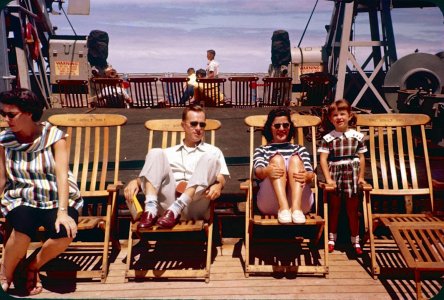
He had Nikkor 50/2 collapsible, 135/4, and 35/3.5. All of our family photos from then until the 80s were shot with that kit, along with some 120 format taken with a Ricohflex TLR.
Here is a Kodachrome photo taken with the 50/2 of my parents and older sister on a ship to Hawaii, where they were on the way to Guam, where he would become a Typhoon Chaser piloting Boeing B-50s.
I've since acquired an equivalent MIOJ kit.

Last edited:
wlewisiii
Just another hotel clerk
I came to Nikon late, but it is a lot of fun and I've learned a lot over the last few years. The closest things to classics I have are
Nikkor N 24/2.8
Nikkor H 28/3.5 (really sweet lens)
Nikkor O 35/2
Nikkor SC 50/1.4 (fun fast lens)
Nikkor P 105/2.5 (chrome nose Sonnar. Tasty lens. Only one on this list)
Nikkor Q 135/3.5 (the other Sonnar, just as fun)
All were bought as pre-AI but only the 28 hasn't been AI'd but my black Nikkormat FTn doesn't mind
I plan to eventually add a Nikkor H 50/2 for fun sometime (grumble physics not letting it be a Sonnar ) as well as a Micro-Nikkor 55/3.5 & PK-3 extension to learn macro shooting.
) as well as a Micro-Nikkor 55/3.5 & PK-3 extension to learn macro shooting.
Oh, and now, thanks to this article, I'll have to keep and eye open for a nicely priced 50/1.2 as well LOL!
Nikkor N 24/2.8
Nikkor H 28/3.5 (really sweet lens)
Nikkor O 35/2
Nikkor SC 50/1.4 (fun fast lens)
Nikkor P 105/2.5 (chrome nose Sonnar. Tasty lens. Only one on this list)
Nikkor Q 135/3.5 (the other Sonnar, just as fun)
All were bought as pre-AI but only the 28 hasn't been AI'd but my black Nikkormat FTn doesn't mind
I plan to eventually add a Nikkor H 50/2 for fun sometime (grumble physics not letting it be a Sonnar
Oh, and now, thanks to this article, I'll have to keep and eye open for a nicely priced 50/1.2 as well LOL!
The Photograph of DDD in "The Great Life Photographers" shows him holding a Leica with the Nikkor 13.5cm F4 on it.Sonnar Brian,
I read in a later edition of "This is War" DDD saying he bought a 135/3.5 rather than the f4. All the non-DDD authored posts state he had the f4. I wonder if you could please check your 1st edition of "This is War' and confirm that he says he took the f4?
The first batch 13.5cm F3.5 came out later than the first visit to Nikon my DDD. The 5cm F1.5 and 13.5cm F4 were in production at the same time. The first version 5cm F1.4 (5005) was in production with the first batch 13.5cm F3.5, (order 5006) which started production in January 1951- according to "Nikon Rangefinder System", Robert Rotoloni. Nikon was eager to have DDD try the new lenses, it is also stated that DDD preferred the 5cm F1.5 over the first version 5cm F1.4. Nikon recomputed the 5cm F1.4 very early, increased the diameter of the optics about 1mm. I've shot the 5cm F1.5 next to an early 5cm F1.4. The F1.5 has smoother Bokeh. I have several 5cm F1.4, 5005 batch, early one in LTM, and (at least) 7 newer ones in S-Mount. The 13.5cm F4 is every bit as good as the newer F3.5, which is a very good lens.
I just read one online article that "does not agree with others that I've read". DDD and Bristol visited the Nikon factory, Duncan shot with a Leica and Horace Bristol used Contax. I've read that Nikon custom cut the cam on the 8.5cm F2 for use on his Contax. DDD bought the 5cvm F1.5 and 13.5cm F4.
Last edited:
pyeh
Member of good standing
Thanks Brian, that's great. That gels with everything written about DDD, but I was confused by what he wrote in that later edition of "This is War". I'll try and borrow it again to cite it properly.
Share:
-
This site uses cookies to help personalise content, tailor your experience and to keep you logged in if you register.
By continuing to use this site, you are consenting to our use of cookies.

